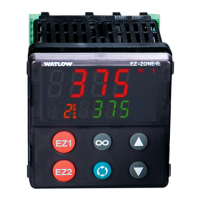Watlow EZ-ZONE
®
PMI Controller • 197 • Chapter 9 Features
Dead Band (cont.)
When the dead band value is a negative value, both heating and cooling outputs are active
when the temperature is near the set point. Adjust the dead band with Dead Band db (Op-
erations Page, Loop Menu).
Variable Time Base
Variable time base is the preferred method for controlling a resistive load, providing a very
short time base for longer heater life. Unlike phase-angle ring, variable-time-base switching
does not limit the current and voltage applied to the heater. With variable time base out-
puts, the PID algorithm calculates an output between 0 and 100%, but the output is distrib-
uted in groupings of three ac line cycles. For each group of three ac line cycles, the control-
ler decides whether the power should be on or off. There is no xed cycle time since the
decision is made for each group of cycles. When used in conjunction with a zero cross (burst
re) device, such as a solid-state power controller, switching is done only at the zero cross of
the ac line, which helps reduce electrical noise (RFI). Variable time base should be used with
solid-state power controllers, such as a solid-state relay (SSR) or silicon controlled rectier
(SCR) power controller. Do not use a variable time base output for controlling electrome-
chanical relays, mercury displacement relays, inductive loads or heaters with unusual resis-
tance characteristics.
The combination of variable time base output and a solid-state relay can inexpensively ap-
proach the effect of analog, phase-angle red control. Select the AC Line Frequency AC.Lf
(Setup Page, Global Menu), 50 or 60 Hz.
Time
Temperature
Negative Dead Band
Set Point
Heat Output Active
Cool Output Active
50 percent output
3 ON, 3 OFF
100 percent output
10 ON, 0 OFF
66 percent output
6 ON, 3 OFF

